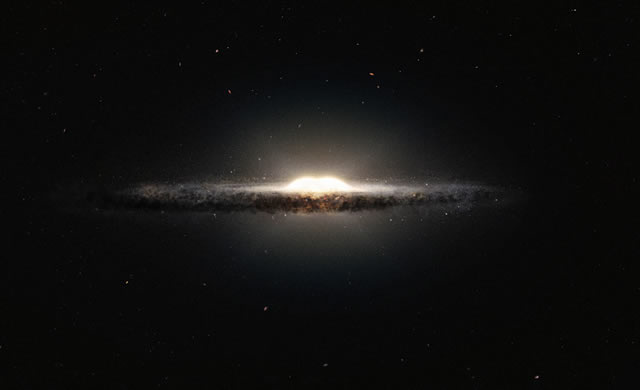
Credit: ESO
Due equipe di astronomi hanno usato dati provenienti dai telescopi dell’ESO per costruire la miglior mappa tridimensionale di sempre della regione centrale della Via Lattea. Hanno scoperto che la regioni interne assumono un aspetto simile a un’arachide, oppure a una X a seconda dell’angolo di vista. Questa strana forma è stata ricostruita usando dati pubblici del telescopio per survey VISTA dell’ESO insieme alla misura del moto di centinaia di stelle deboli del rigofiamento galattico.
Une delle zone più importanti e massicce della galassia è il rigonfiamento galattico: questa enorme nube di circa 10 000 milioni di stelle si estende per migliaia di anni luce, ma la sua struttura e la sua origine non sono mai stati comprese adeguatamente. Sfortunatamente, dal nostro punto di vista all’interno del disco galattico, la visuale sulla regione centrale – a circa 27000 anni luce di distanza – è disturbata da dense nubi di gas e polvere. Gli astronomi possono vedere meglio il rigonfiamento galattico osservando a lunghezze d’onda maggiori, come quelle della radiazione infrarossa, che può penetrare le nubi di polvere. Osservazioni precedenti di tutto il cielo dalla survey infrarossa 2MASS avevano già lasciato intuire che il rigonfiamento galattico ha una strana strutttura a forma di X. Ora due gruppi di scienziati hanno usato nuove osservazioni da diversi telescopi dell’ESO per ottenere una visuale migliore della struttura del rigonfiamento.
Fonte/Leggi tutto → ESO.org
Two groups of astronomers have used data from ESO telescopes to make the best three-dimensional map yet of the central parts of the Milky Way. They have found that the inner regions take on a peanut-like, or X-shaped, appearance from some angles. This odd shape was mapped by using public data from ESO’s VISTA survey telescope along with measurements of the motions of hundreds of very faint stars in the central bulge.
One of the most important and massive parts of the galaxy is the galactic bulge. This huge central cloud of about 10 000 million stars spans thousands of light-years, but its structure and origin were not well understood. Unfortunately, from our vantage point from within the galactic disc, the view of this central region — at about 27 000 light-years’ distance — is heavily obscured by dense clouds of gas and dust. Astronomers can only obtain a good view of the bulge by observing longer wavelength light, such as infrared radiation, which can penetrate the dust clouds. Earlier observations from the 2MASS infrared sky survey had already hinted that the bulge had a mysterious X-shaped structure. Now two groups of scientists have used new observations from several of ESO’s telescopes to get a much clearer view of the bulge’s structure.
Source/Continue reading → ESO.org





















